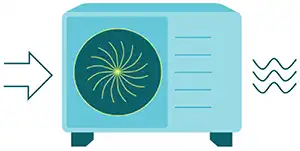From 1st April 2022, many sectors will lose their entitlement to use ‘red’ diesel and rebated biofuel across a variety of applications – and construction is one of the industries that is most affected.
Here’s the lowdown on the key questions construction professionals need to consider in order to ensure a smooth and successful energy mix transition.
What’s changing and why?
Red diesel is just ordinary ‘white’ diesel with a dye in it – but it is taxed at a much lower rate than white diesel. This rebated red fuel was introduced as a concession for certain industrial users in off-highway applications because fuel duty was mainly intended to be a tax on road vehicles.
Changes to this regime were announced by the UK government during Budget 2020 as part of the drive to achieve net-zero carbon emissions by 2050.
After the April 2022 deadline most current users of red diesel will have to switch to white diesel instead. Taxing most users at the full rate is intended to reflect the impact of the emissions they produce, while also promoting the use of cleaner alternatives.
This is great news for the environment but many in the construction industry have been left confused about whether they will be affected by the changes, and how they should demonstrate compliance with the new rules.
Which users are affected?
The government has published guidelines that specify who can still use red diesel and in which applications. One of the biggest changes for construction industry users is that heavy plant and equipment of all kinds will no longer be able to run on red diesel when used for construction purposes.
This includes all non-road mobile machinery (NRMM), including excavators, dumpers and cranes.
The construction industry will also lose permission to use red diesel for commercial heating and power generation, for example when using mobile generators on construction sites.
Certain industries that also use gas oil heavily, such as rail, agriculture, commercial fishing fleets and non-commercial heating or power generation uses, will be exempt from the April 2022 changes.
It’s worth noting that red diesel permissions apply only to the way in which equipment is used, not to the type of equipment itself. So, for example, NRMM that can be used for both agricultural purposes and construction purposes will still be able to run on red diesel, but only in an agricultural context.
What other industries are affected?
Other industries and applications that will no longer be able to rely on red diesel include:
• leisure
• mining and quarrying
• ports
• manufacturing
• airport operations
• oil and gas extraction
• waste management
• commercial heating
How to stay compliant in three simple steps
1. Check the government guidelines – Read the guidelines for red diesel tax rebate changes on the government website and check back regularly in case further changes are made. If you don’t see your intended use of gas oil on the list of approved applications, it’s important to get confirmation from the government before you go ahead with activities or further purchases. Most likely you will no longer be permitted, which means it’s time for step two.
2. Run down your red diesel stocks – In order to stay compliant, it will be essential to run down your existing stocks of red diesel before the 1st April 2022 deadline. In most cases that doesn’t mean you must remove every trace by flushing your tanks. However, you will need to be able to prove that you haven’t purchased any red diesel after the April 2022 deadline, or stockpiled close to this date.
Run down your red diesel efficiently by first making sure you have a precise measurement of how much you have left in storage. Next, draft up a timeline of usage to predict when you would run out, and make a plan for integrating alternative fuel replacements at the right time to ensure there will be no interruption to your operations.
3. Save your invoices – Of course, it’s good practice to retain purchase and payment records at any time, but when it comes to your gas oil procurement, your records will become indispensable – providing evidence that you won’t have purchased the fuel after or close to the April 2022 deadline. You will need to have all purchasing and delivery documentation available, in order to provide HMRC inspectors with a clear audit trail upon request.
The financial implications
Right now, ordinary white diesel is taxed at the full rate of 57.95 pence per litre (ppl). By contrast, red diesel is entitled to a rebate of 46.81ppl meaning that it is effectively taxed at only 11.14ppl.
Users who have to switch from red diesel to white diesel next year will therefore have to pay five times as much fuel duty as before. These companies will also need to consider the one-off costs of staying compliant. These may include the expense of removing or running down stocks of red diesel, purchasing additional fuel storage tanks, vehicles or equipment, sourcing reliable alternative fuels and more.
Furthermore, both red and white diesel will become even more attractive targets for theft. The construction industry is particularly vulnerable, considering the high numbers of vehicles and large stores of fuel on construction sites.
Stay smart to prevent theft
As higher volumes of undyed white diesel arrive on construction sites, the growing challenge of fuel theft is expected to become an even bigger problem – an increase of both red and white fuel theft is already being reported.
Extra surveillance is essential, but technology is available to enhance security. Smart tanks and locks keep your fuel secure, while a tank telemetry system offers a way to monitor fuel levels in real time.
The right telemetry system will send an alert directly to your smartphone as soon as any unusual fuel usage pattern is detected, such as a sudden drop. This not only signals a potential theft but also helps you stay on top of any fuel leaks.
Alternative fuels
The red diesel rule changes are likely to be followed with more regulatory measures to drive UK industry towards a cleaner future. Many users are already exploring the growing variety of cleaner-burning alternatives to diesel that are already on the market.
Fortunately, many of these are convenient drop-in solutions, allowing you to simply swap to a different liquid fuel without any engine modifications, and without any need to replace your vehicles, machinery or equipment
GTL (Gas-to-Liquid) Fuel technology converts natural gas into a paraffinic fuel that’s suitable for both on- and off-road applications. Compared to diesel, GTL fuel produces fewer pollutants while also decreasing noise and odour pollution. GTL also helps to improve cold starts and reduces clogged filters, while offering a long shelf life that’s well-suited for use in back-up power generators, and for final fill before winter begins – without any modifications to vehicles or engines or investment in additional infrastructure.
Hydrotreated vegetable oil (HVO) is produced from vegetable fats and oils, such as cooking oil. It offers an improved burn efficiency and reduced carbon emissions, which accounts for a significant decrease in GHG emissions. Hydrogen is used as a catalyst rather than methanol, which means that HVO is cleaner-burning and has a longer shelf life than standard biofuel. The HVO supply chain is currently under close scrutiny, with the aim of ensuring consistent high-quality and sustainable supply.
Industrial heating oil/Therma35 is ideal for use in commercial boilers, heaters, driers and furnaces, offering significant savings across a range of heating applications. It not only burns more slowly than gas oil or kerosene, but also offers long-term storage stability, which reduces the risk of spoilage, interruption or waxing.
Kerosene – Also known as paraffin, kero or 28-second oil, kerosene is well-established as a low-viscosity oil for heating applications that has a lower freezing point than diesel.
A dilemma for plant hirers
Because the red diesel rule changes apply to the way in which equipment is used, not to the type of equipment itself, hirers or contractors who supply equipment across various industries may be particularly affected by the change.
If your equipment can be used for both construction and agricultural purposes, for example, you will need to make sure that after working on a farm no traces of red diesel remain in the tank when that equipment is fuelled for use on a construction site (or for any other application that is no longer permitted).
Some users will therefore need to keep supplies of both red and white diesel and will be required to flush tanks and supply lines in-between uses in order to remain compliant. The alternative is to invest in additional plant and/or equipment, reserving one for running on red diesel only.








